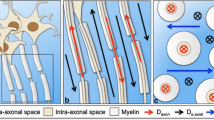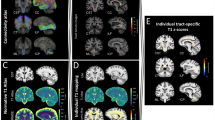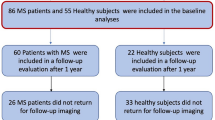Abstract
Although diffusion tensor imaging (DTI) and the magnetization transfer ratio (MTR) have been extensively studied in multiple sclerosis (MS), it is still unclear if they are more effective biomarkers of disability than conventional MRI. MRI scans were performed on 117 participants with MS in addition to 26 healthy volunteers. Mean values were obtained for DTI indices and MTR for supratentorial brain and three white matter tracts of interest. DTI and MTR values were tested for correlations with measures of atrophy and lesion volume and were compared with these more conventional indices for prediction of disability. All DTI and MTR values correlated to an equivalent degree with lesion volume and cerebral volume fraction (CVF). Thalamic volumes correlated with all indices in the optic radiations and with mean and perpendicular diffusivity in the corpus callosum. Nested model regression analysis demonstrated that, compared with CVF, DTI indices in the optic radiations were more strongly correlated with Expanded Disability Status Scale and were also more strongly correlated than both CVF and lesion volume with low-contrast visual acuity. Abnormalities in DTI and MTR are equivalently linked with brain atrophy and inflammatory lesion burden, suggesting that for practical purposes they are markers of multiple aspects of MS pathology. Our findings that some DTI and MTR indices are more strongly linked with disability than conventional MRI measures justifies their potential use as targeted, functional system-specific clinical trial outcomes in MS.

Similar content being viewed by others
References
Barkhof F (2002) The clinico-radiological paradox in multiple sclerosis revisited. Curr Opin Neurol 15(3):239–245
Filippi M et al (2001) Diffusion tensor magnetic resonance imaging in multiple sclerosis. Neurology 56(3):304–311
Filippi M et al (1995) A magnetization transfer imaging study of normal-appearing white matter in multiple sclerosis. Neurology 45(3 Pt 1):478–482
Filippi M, Rocca MA, Comi G (1998) Magnetization transfer ratios of multiple sclerosis lesions with variable durations of enhancement. J Neurol Sci 159(2):162–165
DeBoy CA et al (2007) High resolution diffusion tensor imaging of axonal damage in focal inflammatory and demyelinating lesions in rat spinal cord. Brain 130(Pt 8):2199–2210
Song SK et al (2005) Demyelination increases radial diffusivity in corpus callosum of mouse brain. Neuroimage 26(1):132–140
Zhang J et al (2009) Diffusion tensor magnetic resonance imaging of wallerian degeneration in rat spinal cord after dorsal root axotomy. J Neurosci 29(10):3160–3171
Schmierer K et al (2007) Quantitative magnetization transfer imaging in postmortem multiple sclerosis brain. J Magn Reson Imaging 26(1):41–51
Reich DS et al (2009) Damage to the optic radiation in multiple sclerosis is associated with retinal injury and visual disability. Arch Neurol 66(8):998–1006
Giorgio A et al (2010) Relationships of brain white matter microstructure with clinical and MR measures in relapsing-remitting multiple sclerosis. J Magn Reson Imaging 31(2):309–316
Agosta F et al (2006) Magnetization transfer MRI metrics predict the accumulation of disability 8 years later in patients with multiple sclerosis. Brain 129(10):2620–2627
Harrison DM et al (2011) Longitudinal changes in diffusion tensor-based quantitative MRI in multiple sclerosis. Neurology 76(2):179–186
Reich DS et al (2010) Automated vs. conventional tractography in multiple sclerosis: variability and correlation with disability. Neuroimage 49(4):3047–3056
Ozturk A et al (2010) MRI of the corpus callosum in multiple sclerosis: association with disability. Mult Scler 16(2):166–177
Shiee N et al (2010) A topology-preserving approach to the segmentation of brain images with multiple sclerosis lesions. Neuroimage 49(2):1524–1535
Shiee N et al (2012) Revisiting brain atrophy and its relationship to disability in multiple sclerosis. PLoS ONE 7(5):e37049
Kurtzke JF (1983) Rating neurologic impairment in multiple sclerosis: an expanded disability status scale (EDSS). Neurology 33(11):1444–1452
Cutter GR et al (1999) Development of a multiple sclerosis functional composite as a clinical trial outcome measure. Brain 122(5):871–882
Fischer JS et al (1999) The multiple sclerosis functional composite measure (MSFC): an integrated approach to MS clinical outcome assessment. National MS Society Clinical Outcomes Assessment Task Force. Mult Scler 5(4):244–250
Rudick R et al (1997) Recommendations from the National Multiple Sclerosis Society Clinical Outcomes Assessment Task Force. Ann Neurol 42(3):379–382
Baier ML et al (2005) Low-contrast letter acuity testing captures visual dysfunction in patients with multiple sclerosis. Neurology 64(6):992–995
Balcer LJ, Frohman EM (2010) Evaluating loss of visual function in multiple sclerosis as measured by low-contrast letter acuity. Neurology 74(Suppl 3):S16–S23
Henry RG et al (2009) Connecting white matter injury and thalamic atrophy in clinically isolated syndromes. J Neurol Sci 282(1–2):61–66
De Stefano N et al (2002) MR correlates of cerebral atrophy in patients with multiple sclerosis. J Neurol 249(8):1072–1077
Petzold A, Tozer DJ, Schmierer K (2011) Axonal damage in the making: neurofilament phosphorylation, proton mobility and magnetisation transfer in multiple sclerosis normal appearing white matter. Exp Neurol 232(2):234–239
Pulizzi A et al (2007) Determinants of disability in multiple sclerosis at various disease stages: a multiparametric magnetic resonance study. Arch Neurol 64(8):1163–1168
Ceccarelli A et al (2007) Normal-appearing white and grey matter damage in MS. A volumetric and diffusion tensor MRI study at 3.0 Tesla. J Neurol 254(4):513–518
Vrenken H et al (2010) Diffusely abnormal white matter in progressive multiple sclerosis: in vivo quantitative MR imaging characterization and comparison between disease types. Am J Neuroradiol 31(3):541–548
Tsunoda I et al (2003) Axonal injury heralds virus-induced demyelination. Am J Pathol 162(4):1259–1269
Trapp BD et al (1998) Axonal transection in the lesions of multiple sclerosis. N Engl J Med 338(5):278–285
Bodini B et al (2009) Exploring the relationship between white matter and gray matter damage in early primary progressive multiple sclerosis: an in vivo study with TBSS and VBM. Hum Brain Mapp 30(9):2852–2861
van den Elskamp IJ et al (2010) Lesional magnetization transfer ratio: a feasible outcome for remyelinating treatment trials in multiple sclerosis. Mult Scler 16(6):660–669
Fox RJ et al (2011) Measuring myelin repair and axonal loss with diffusion tensor imaging. Am J Neuroradiol 32(1):85–91
Fink F et al (2010) Comparison of diffusion tensor-based tractography and quantified brain atrophy for analyzing demyelination and axonal loss in MS. J Neuroimaging 20(4):334–344
Preziosa P et al (2011) Intrinsic damage to the major white matter tracts in patients with different clinical phenotypes of multiple sclerosis: a voxelwise diffusion-tensor MR study. Radiology 260(2):540–550
Acknowledgments
The MRI data was acquired through National MS Society Tissue Repair grant TR3760A3 and through a grant from EMD Serono. Research support was also obtained through NINDS grant K99NS064098 from the Intramural Research Program of the National Institute of Neurological Disorders and Stroke, and NINDS grant R01NS070906.
Conflicts of interest
Dr. Calabresi has received research support and consultation fees from EMD Serono. Otherwise, the authors declare no financial relationships with the supporting entities of this study.
Ethical standards
All human studies have been approved by the appropriate ethics committee and have therefore been performed in accordance with the ethical standards laid down in the 1964 Declaration of Helsinki.
Author information
Authors and Affiliations
Corresponding author
Electronic supplementary material
Below is the link to the electronic supplementary material.
Rights and permissions
About this article
Cite this article
Harrison, D.M., Shiee, N., Bazin, PL. et al. Tract-specific quantitative MRI better correlates with disability than conventional MRI in multiple sclerosis. J Neurol 260, 397–406 (2013). https://doi.org/10.1007/s00415-012-6638-8
Received:
Revised:
Accepted:
Published:
Issue Date:
DOI: https://doi.org/10.1007/s00415-012-6638-8




